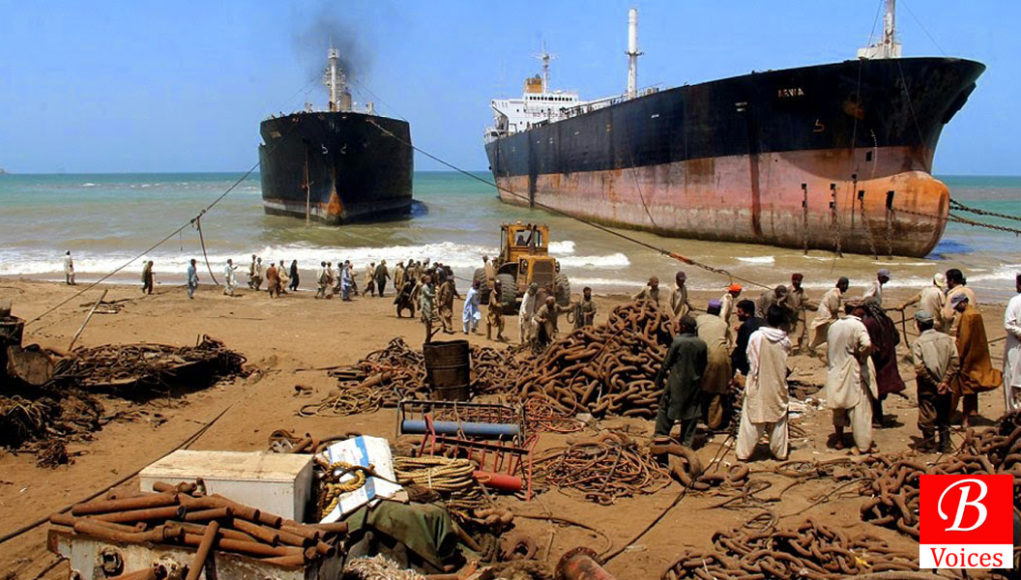Ayaz khan
Within countries relying on agriculture and fisheries for having a stable economy, ship-breaking industries are believed to have become an important support for economic boost. Though the world has changed its routes toward achieving a sustainable economic growth, countries such as India, Bangladesh and Pakistan still churn out a big chuck of revenue in form of taxes from their ship-breaking industries. Apart from generating sustainable revenue from these privately-owned ship dismantling companies, Pakistan, India and Bangladesh remain hazardous places for decommissioning of obsolete vessels.
Following a tragic incident at Gaddani ship-breaking yard on November 1 in which at least 28 workers lost their lives –though the unofficial figure exceeds 60— working at Gaddani breaking yard has come to a grinding halt after imposition of section 144 by the government. However, the ship-breaking industry, on December 3, 2016, made an appeal, titled Gaddani—the way forward, via pages of Dawn for lifting up section 144 to restore work at the breaking yard.
Read also: Gaddani Ship-breaking Yard: A Tale of Worker’s plight
Ridiculously, the appeal-cum-advertisement reflected industry’s helplessness and it’s flawed functioning since its establishment. Moreover the industry leapt miles ahead to legitimize its operation while connecting its closure with CPEC’s smooth operation in future. Interestingly, on few pages ahead, Dawn through its editorial objected on the industry’s claim about interweaving lack of steel production as an obstacle in CPEC’s smooth operation.
‘The CPEC projects, which represent $46 billion investment in Pakistan and are at the take off stage, have also been affected by the closure of industry,’ read the appeal. It seems the entire edifice of CPEC is linked to the ship-breaking industry’s operation. If industry stopped producing dismantled steel–heavens forgive– the edifice of CPEC would collapse. This is a naïve attempt to legitimize the deadly business of ship breaking at Gaddani.
The industry, through its holier than though approach, attempted to have government recount industry’s contribution to the national exchequer which, according to industry, stood 12 billion annually in form of taxes vis a vis it went on portraying industry’s might in terms of dismantling 100 vessels annually. However, the numerical data does provide legitimacy to the industry’s claim, but for merely curtaining the flaws on the ground.
The recent colossal lose of 28 precious lives has exposed numerous inadequacies within the industry’s safe working structure. Substantially, the fatality rate at Gaddani is lower than that of Chittagong in Bangladesh and Alang in India. According to International Law and Policy Institute (ILPI’s) report: Ship breaking Practice in Bangladesh, India and Pakistan, from 2005-2013 90 workers had lost their lives at Chittagong ship-breaking yard. Report also highlights that from 1983-2013, around 470 workers had died in accidents in Alang while raising the fatality rate six times higher than in the Indian mining industry.
Given the lack of data available regarding fatal accidents at Gaddani ship-breaking yard, an actual account of labourers’ death incidents remains an intricate issue to jump on relevant figures. For instance, an issue paper released by International Labour Office Geneva in 2000, highlights measures taken by both India and Bangladesh for workers safety and environmental degeneration; however, about Pakistan, the page remains confined to some verbosity about vessels’ nature beached at Gaddani breaking yard instead of providing relevant data given the lack of sources available to accumulate evidences of fatal incidents. But, the ILPI’s report published in May, does have some data about worker’s death. ‘In 2012, a Pakistani trade union recorded 12 deaths at Gaddani ship-breaking yard,’ reveals the report.
Notably, the ship-breaking yard at Gaddani has a huge capacity to dismantle at least 125 ships annually including heavy tonnage cargos which means 8-10 vessels per month. Contrary to this, the heavy tonnage cargos are the most dangerous as they are oil tankers mostly. The recent deadliest incident was one of the terrible results of ‘beaching’ oil cargos without taking prior safety measures.
In fact, the Gaddani ship-breaking industry’s appeal for restoration of work at the breaking yard along with demanding medical, fire fighting facilities, and a proper infrastructure is justification of its negligence for putting workers life at risk since its establishment.
The South Asian ship-breaking industries are almost functioning contrary to International Labour Organization’s guidelines which at first place put the workers’ safety first and then environmental hazards. At breaking yards, workers are also exposed to deleterious particles which have short and long-term health effects.
Before giving green signal to the merchants of death for going back to their deadly business, issues of providing personal protective equipment (PPE), complying with ILO’s set guidelines and ensuring removal of hazardous material before beaching vessels must be redressed. But above all, the industry owners must be asked what penalties must be employed for such negligence in future? After all, the industry is entrusted with the lives of labourers.
Writer is a journalist associated with Balochistan Voices
Share your comments!








